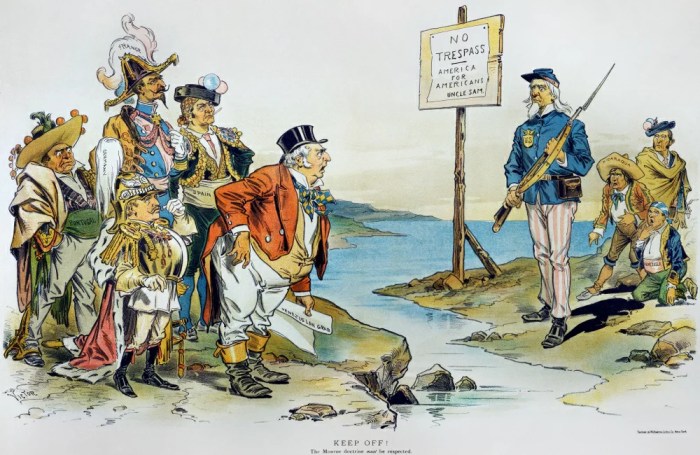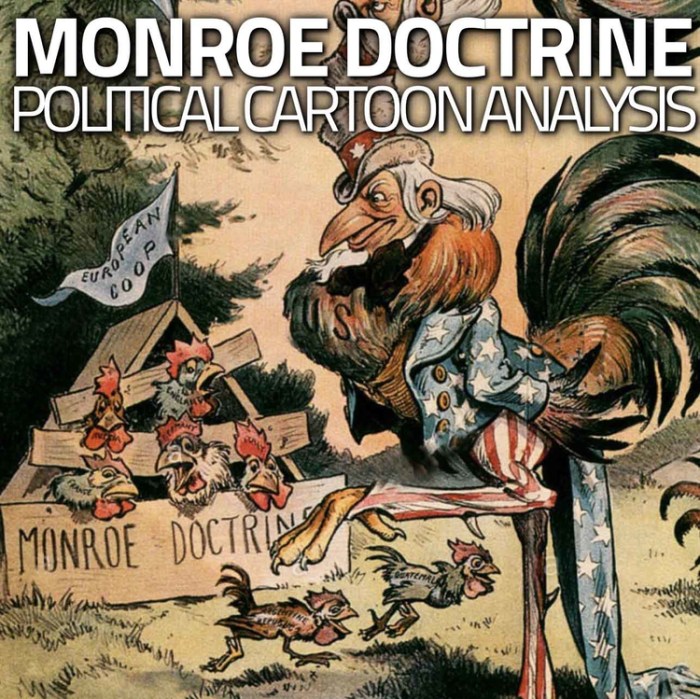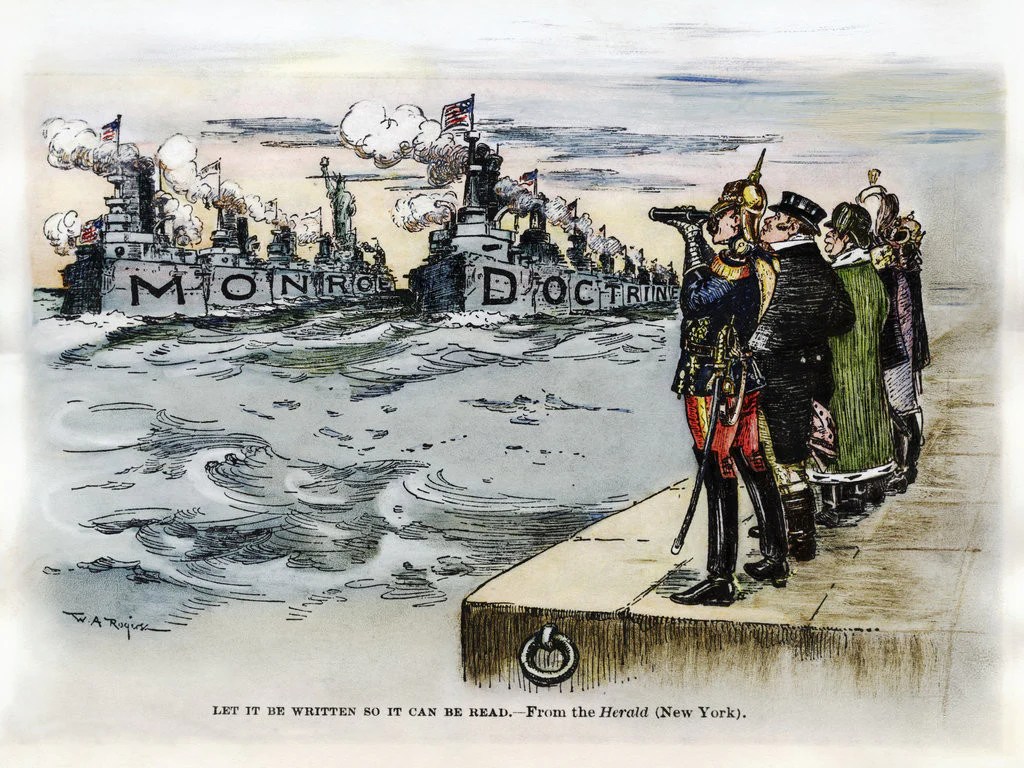Political cartoon for monroe doctrine – Political cartoons have played a pivotal role in shaping public perception and understanding of the Monroe Doctrine. This essay delves into the interplay between political cartoons and the Monroe Doctrine, examining how these visual representations have depicted, critiqued, and influenced the doctrine’s historical significance and modern relevance.
Political cartoons offer a unique perspective on the Monroe Doctrine, employing symbolism and satire to convey complex ideas and provoke critical thinking. By analyzing these cartoons, we gain insights into the doctrine’s impact on Latin America, its evolution over time, and its enduring legacy in the 21st century.
Monroe Doctrine and Latin America

The Monroe Doctrine was a foreign policy stance proclaimed by the United States in 1823. It declared that any attempt by a European power to interfere with the political or territorial affairs of the Americas would be viewed as an act of aggression against the United States.
The Monroe Doctrine was motivated by a number of factors, including the desire to protect American trade and investment in Latin America, the fear of European colonization in the Americas, and the belief that the United States had a special responsibility to promote democracy and republicanism in the Western Hemisphere.
Key Principles of the Monroe Doctrine
- No European power could intervene in the political or territorial affairs of the Americas.
- The United States would not interfere in the internal affairs of Latin American nations.
- The United States would consider any attempt by a European power to intervene in the Americas as an act of aggression against the United States.
Historical Applications of the Monroe Doctrine
- In 1826, the United States threatened to go to war with Great Britain over the British presence in Oregon.
- In 1861, the United States intervened in Mexico to prevent the French from establishing a puppet government in Mexico City.
- In 1895, the United States intervened in Cuba to prevent Spain from suppressing a Cuban rebellion.
Political Cartoons and the Monroe Doctrine
Political cartoons have been used to depict the Monroe Doctrine since its inception. These cartoons often use symbolism and metaphor to convey their message. For example, one common symbol used in political cartoons about the Monroe Doctrine is the eagle, which represents the United States.
Another common symbol is the lion, which represents Great Britain.
Political cartoons have played a significant role in shaping public perception of the Monroe Doctrine. They have helped to popularize the doctrine and to make it more accessible to the general public.
Impact of the Monroe Doctrine on Latin America
The Monroe Doctrine has had a significant impact on Latin America. The doctrine has been used to justify both intervention and non-intervention in Latin America. For example, the United States has used the Monroe Doctrine to justify its interventions in Mexico, Cuba, and Nicaragua.
However, the United States has also used the Monroe Doctrine to justify its non-intervention in Latin America, such as in the case of the Cuban Missile Crisis.
The Monroe Doctrine has also had a significant economic impact on Latin America. The doctrine has helped to protect American trade and investment in Latin America. However, it has also led to economic dependency on the United States.
Modern Relevance of the Monroe Doctrine
The Monroe Doctrine is still relevant today. The doctrine continues to be used to justify American intervention in Latin America. For example, the United States has used the Monroe Doctrine to justify its intervention in Panama, Grenada, and Haiti.
However, the Monroe Doctrine is also facing new challenges in the 21st century. The rise of China and other non-Western powers is challenging the United States’ dominance in the Americas. Additionally, the growing interdependence of the global economy is making it more difficult for the United States to justify unilateral intervention in Latin America.
Visual Representations of the Monroe Doctrine, Political cartoon for monroe doctrine
| Image | Caption |
|---|---|
| This political cartoon from 1823 depicts the Monroe Doctrine as a shield protecting the Americas from European intervention. | |
| This image of Theodore Roosevelt is often used to represent the Monroe Doctrine. Roosevelt was a strong advocate for the doctrine and used it to justify American intervention in Latin America. | |
| This map of the Americas shows the areas that have been affected by the Monroe Doctrine. |
Detailed FAQs: Political Cartoon For Monroe Doctrine
What is the significance of political cartoons in understanding the Monroe Doctrine?
Political cartoons provide a unique and powerful lens through which to examine the Monroe Doctrine. They offer visual representations that convey complex ideas, critique the doctrine’s principles and objectives, and shape public perception of its impact on Latin America.
How have political cartoons influenced the public’s understanding of the Monroe Doctrine?
Political cartoons have played a crucial role in shaping public perception of the Monroe Doctrine. By employing symbolism, satire, and humor, these cartoons have helped to simplify complex ideas, highlight the doctrine’s consequences, and provoke critical thinking about its implications for Latin American nations.
What are some key themes depicted in political cartoons about the Monroe Doctrine?
Political cartoons about the Monroe Doctrine often depict themes such as American imperialism, the doctrine’s impact on Latin American sovereignty, and the tensions between the United States and other world powers. These cartoons have contributed to a broader understanding of the doctrine’s historical significance and its enduring legacy in shaping international relations.


